
Welcome to raleighsnakes.com! I am David, a snake enthusiast living in Raleigh, NC. Many people don't know that Raleigh is in fact full of snakes! You just need to know where to find them - they can often be shy and elusive. Some North Carolina snake species are more common outside of the city limits, in different parts of Wake County NC, but many types of snakes are indeed common in the more urban parts of Raleigh. This guide is meant to help educate you about the beautiful snakes of Raleigh, and to help you identify the most common snakes of Raleigh, as well as the venomous snakes of Raleigh that you should learn to recognize and avoid. If you want more detail, click here for my complete list of ALL snake species in Raleigh. Remember the following:
- Most snakes of Raleigh are harmless and don't want to encounter you
- Venomous snakes exist but are uncommon in Raleigh, North Carolina
- Snakes eat rats and mice and are a valuable part of the North Carolina ecosystem
- Never kill a snake - if you leave a snake alone, it will leave you alone.
Common Snake Species in Raleigh
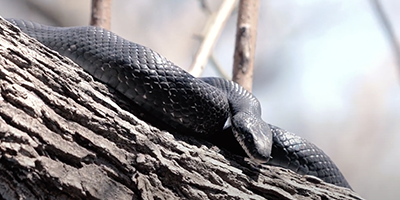 Eastern Rat Snake:
The eastern rat snake (Pantherophis alleghaniesnsis) is endemic to the eastern-southeastern United States. They are typically found in meadows and open wooded areas but are attracted to areas with cover and any place with rodents to hunt. They are not venomous but do emit a foul musk when threatened that smells like and has the taste of poison.
Eastern Rat Snake:
The eastern rat snake (Pantherophis alleghaniesnsis) is endemic to the eastern-southeastern United States. They are typically found in meadows and open wooded areas but are attracted to areas with cover and any place with rodents to hunt. They are not venomous but do emit a foul musk when threatened that smells like and has the taste of poison.Eastern rat snakes can be fairly large. The adults average between 3 and a half feet and 7 feet long. The black scales on their back are shiny and they have light-colored bellies, with white scales at the throat and chin. The head is wider than the rest of the body. They brumate in cold months. Brumation is similar to hibernation but the snake occasionally awakens for activities like drinking water.
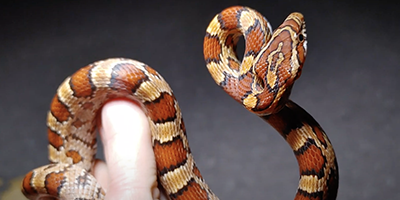 Corn Snake:
The brightly colored corn snake (Pantherophis guttatus) is a very common snake found in the southeastern and central United States. They are found in a variety of habitats, including overgrown fields and gardens, forests, trees, and palmetto flatwoods. They like abandoned and seldom-used buildings. They can be found from sea level to mountain areas as high as 6,000 feet. They are not venomous and have become a popular breed of snake to keep as a pet.
Corn Snake:
The brightly colored corn snake (Pantherophis guttatus) is a very common snake found in the southeastern and central United States. They are found in a variety of habitats, including overgrown fields and gardens, forests, trees, and palmetto flatwoods. They like abandoned and seldom-used buildings. They can be found from sea level to mountain areas as high as 6,000 feet. They are not venomous and have become a popular breed of snake to keep as a pet.The corn snake gets its name from the maize-like pattern that makes it so distinctive. They have been selectively bred for a wide variety of colors, though yellow and orange combinations still predominate. Orange with black lines is the most common in North Carolina corn snakes. Corn snakes are voracious rodent eaters and have been very beneficial for human beings because they help control rodent populations, particularly around gardens and farms. They hibernate during the winter in colder climates.
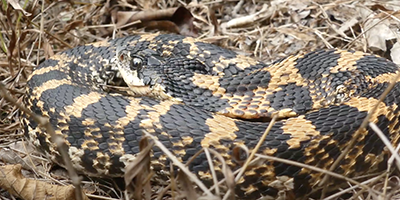 Hognose Snake:
The hognose snake (Heterodon platirhinos) is a common species of snake in the United States that can be found from as far north as southern Minnesota and New Hampshire, to Kanas, and as far south as Florida and Texas. They like areas with sandy soil and woodlands. In urban settings, it is attracted to piles of debris and construction sites with exposed soil. They prey mainly on amphibians, such as toads, and have fangs with an amphibian-specific venom that is not deadly or even harmful to humans. They are considered non-venomous.
Hognose Snake:
The hognose snake (Heterodon platirhinos) is a common species of snake in the United States that can be found from as far north as southern Minnesota and New Hampshire, to Kanas, and as far south as Florida and Texas. They like areas with sandy soil and woodlands. In urban settings, it is attracted to piles of debris and construction sites with exposed soil. They prey mainly on amphibians, such as toads, and have fangs with an amphibian-specific venom that is not deadly or even harmful to humans. They are considered non-venomous.The hognose snake gets its name from its most distinctive feature- an upturned nose that is useful for digging in sandy soil. They come in a wide variety of colors and can be a mix of red, green, orange, brown, yellow, grey, or black. They also have a wide variety of markings. They tend to have lighter bellies that are tan, cream-colored, or grey. The average adult is 28 inches and females tend to be larger than males.
Venomous Snake Species in Raleigh
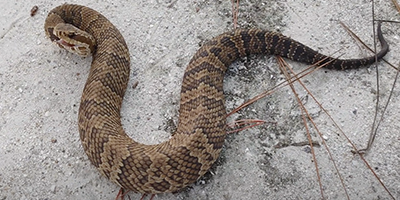 Cottonmouth:
The cottonmouth snake (Agkistrodon piscivorus) can be found throughout the southeast from Virginia to Georgia and into Texas. They are also known as water moccasins and they like swamps, floodplains, and wetlands. They can be away from water as well. They particularly like drying pools where they can feed on fish and amphibians. They are venomous.
Cottonmouth:
The cottonmouth snake (Agkistrodon piscivorus) can be found throughout the southeast from Virginia to Georgia and into Texas. They are also known as water moccasins and they like swamps, floodplains, and wetlands. They can be away from water as well. They particularly like drying pools where they can feed on fish and amphibians. They are venomous.Cottonmouth snakes have triangular-shaped heads with large jowls that hold their venom. They come in a variety of colors and are usually marked with dark crossbands on a brown or yellow ground color, some are completely brown or black. Their bellies usually have brownish-yellow blotches. They are typically 24 to 48 inches long. They are migratory and vulnerable to loss of habitat.
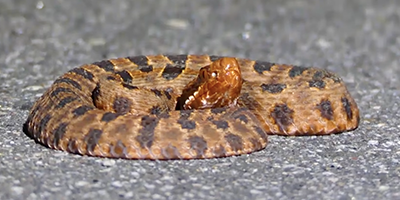 Eastern Pygmy Rattlesnake:
The eastern pygmy rattlesnake (Sistrurus Milliarius) can be found across the southeastern United States from the Carolinas down to Florida, and west as far as Louisiana and Texas. They are found near lakes and marshlands. They also make their homes in flatwoods, sandhills, mixed forests, and floodplains. They like to hide in leaf piles. They are venomous. Interestingly, the cytotoxin they produce has hemorrhagic properties and was the basis for a drug that is used to prevent clotting during heart attacks.
Eastern Pygmy Rattlesnake:
The eastern pygmy rattlesnake (Sistrurus Milliarius) can be found across the southeastern United States from the Carolinas down to Florida, and west as far as Louisiana and Texas. They are found near lakes and marshlands. They also make their homes in flatwoods, sandhills, mixed forests, and floodplains. They like to hide in leaf piles. They are venomous. Interestingly, the cytotoxin they produce has hemorrhagic properties and was the basis for a drug that is used to prevent clotting during heart attacks.The eastern pygmy rattlesnake ranges in color from pale blue to light brown to orange to black. They have black patches with uneven borders and nine large scales on their heads. Adults are typically 16 to 24 inches in length. They consume a variety of prey such as small mammals, insects, centipedes, lizards, and frogs. They use their yellow tails to lure prey.
If you're unsure, you can email me a photo of the snake at info@raleighsnakes.com and I will email you back with the snake's species. If you found a snake skin, read my Found a Skin? page, and you can email me a photo of the skin, and I'll identify the snake for you. If you need professional Raleigh snake removal help, click my Get Help page, or see the below website sponsor I found, who provides that service.
An Overview of the Snake Territory
Territorial behavior, wherein the dominant animal will have immediate access to essential resources before the subordinates have been observed on different animals, including snakes. On serpents, territoriality is a means for them to protect and monopolize their food source. The Taiwanese Kukrisnakes have been observed defending the turtle's nest aggressively. The male snakes will also defend their territory during the breeding season. By defending his site, it increases the reproductive success of the snake.
How Big is the Snake's Territory?
Knowing how large the territory of the snake is will help you keep away from the perimeter of their possible attack. Understand that most of the snake's attack happened due to some people trying to encroach their territory. Luckily, the territorial behavior of the snake is not as pronounced compared to other creatures. The snakes can be solitary creatures, but they are willing to share their den with other snakes to share warmth during the winter season.
Most snakes will have their home range. Inside an extensive range will be smaller territory that they are familiar with. They may have a home for their winter and summer. It has been noted that the snakes will return to the same home range during winter. However, due to some people taking the rocks for landscaping, they may not have enough time to look for a new shelter and die in the cold season. Snakes prefer to travel as close as possible. If they can find all they need within a 10-meter area, then it is possible that they will not leave the place. The size of their territory will vary, but generally, it should cover their foraging site, cover, and basking area.
Can the Snakes Find its Way Back Home?
When you capture a snake, you need to know whether it can return to its territory. It will help you find the ideal place to relocate them. However, be sure that snake relocation is done with the assistance of the experts. Most animals will die if they have been relocated without considering some important facts. In the study at the University of Kent, ten male snakes have been fitted with radio tags. They realized that most of the relocated snakes would exhibit a higher movement rate than the snakes that are already in that area. Moreover, one snake was able to return to its original location. The snake could move to a greater distance and even expose itself to some elements such as predators in the process.
There are at least 3,000 snake species, and each of them will have unique behavior. Additionally, the range of their territory may also differ. When establishing a territory, they make sure that all things they need to survive can be found in a single place. For instance, there should be a source of food and water, shelter, coverings, and basking sites that will help them regulate their body temperature. It should also be free from predators and safe from other outdoor elements.
Remember, the term is not poisonous snakes of Raleigh, it's venomous snakes of Raleigh. Poison is generally something you eat, and venom is injected into you. That said, dangerous snakes are very rare in Raleigh. The few venomous snakes of Wake County are rarely seen. But they are commonly misidentified, so learn about all the snake species of Raleigh in order to correctly identify them. These snakes are usually also found in the surrounding towns of Raleigh, Apex, Garner, Fuquay-Varina, Holly Springs, Knightdale, Morrisville, Zebulon, Wendell, Rolesville, and the surrounding areas.
Read our article about:
Homemade Snake Repellents
raleighsnakes.com domain and hosting costs made possible by the generous support of this sponsor:
